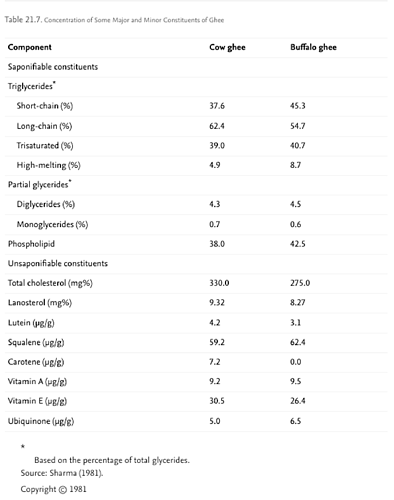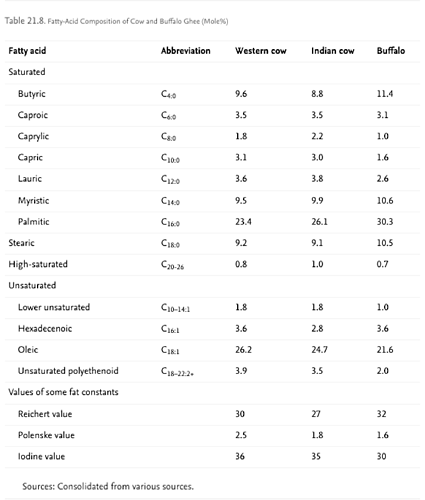For the curious or those who don’t have clue what we’re talking about, here are the basics:
Importance of ghee
Modern science now verified, what Ayurvedic health science has said since thousands years ago: Ghee is a health booster, offers cooking benefits and is good for the mind and spirit. Here are a few benefits:
Ghee is considered as ideal medium for deep frying because it possess high smoke point (250 °C) which is well above the normal cooking temperatures (180-200 °C) and also higher than most of the vegetable oils (Bader, 2010; Deosarkar et al, 2016). Ghee does not require refrigeration conditions to store, therefore does not spoil easily. It is not likely to affect people with a dairy or casein intolerance. Ghee is made from butter but the milk solids and impurities have been removed, so most people who are lactose or casein intolerant have no issue with ghee. It is rich in the oil soluble vitamins A and E (Achaya, 1997) and also rich in vitamin K2 and CLA (Conjugated Linoleic Acid); an antioxidant with anti-viral and anti-cancer properties, if sourced from grass fed cows (Dhiman et al, 1999, 2000).
Ghee is nutritionally superior to other oils/fats because of its medium chain fatty acids (MCFAs) content, which are absorbed directly by the liver and burned to provide energy. Therefore, for athletes it can be of consistent energy source. Also, the energy from medium chain fatty acids can be used to burn other fats in the system and to lose weight (St-Onge & Jones, 2008: Nokasa et al, 2009), therefore the anti-obesity properties of these MCFAs are well recognized. Ghee (unlike other oils)
exclusively contain butyric acid; a short chain fatty acid (Kumar et al, 2015), which contributes to its distinct flavor and easy digestion. Beneficial intestinal bacteria convert fiber into butyric acid and then use that for energy and intestinal wall support (Maurice Bugaut, 1987). A healthy body therefore makes its own form of ‘ghee’ but we are aiding that greatly by consuming of it. It is proved that people with unhealthy digestive tracts do not produce butyric acid. Research shows that adequate production of butyric acid supports the production of killer T cells in the gut and thus a strong immune system (Chang et al, 2014).
In addition, ghee based formulations are well scripted in Ayurvedic system of medicines used for wound healing purposes (Vure & Dorle, 2006). It was also observed that when rats fed with diets containing greater than 2.5 wt% of ghee showed lower levels of serum cholesterol compared with rats fed diets containing groundnut oil (Matam et al, 2000). Another study revealed that the consumption of ghee up to a 10% level in the diet altered blood lipid profiles in such a manner as not to elevate the risk factors for cardiovascular diseases (Matam et al, 1999). Ayurvedic physicians have been using ghee enemas for centuries to decrease inflammation.
Ghee stimulates the secretion of gastric acid, thus aiding in the digestive process.
In Ayurveda, ghee is placed under most satvic foods, and is considered to promote positivity, growth and expansion of consciousness. The positive subtle effects of ghee is said to come from the fact that it comes freely from cows. Cows are domestic animal in most parts of the world, but these are considered special and holy in Hindu cultures of India. Therefore, the milk from cows contains the essence of all those energies, and ghee is the essence of the milk. Ghee is used as a suitable carrier for many herbs and spices with different medicinal properties, which are to be absorbed and transported to targeted areas of the body. This is why, Ayurveda uses ghee in thousands of different herbal preparations for curing various ailments.
Conclusion
Ghee has been considered immensely superior to other fats mainly because of the presence of characteristic short chain fatty acids, carrier of four fat soluble vitamins viz., A, D, E, K and essential fatty acids such as linolenic acid and arachidonic acid. The market penetration of ghee is about 37% in urban areas and about 21% in rural areas. Daily consumption of ghee in an adequate amount, imparts various health benefits such as binds toxins, enhances complexion and glow of the face and body, a great rejuvenator for the eyes, increases physical and mental stamina etc. in addition to providing
sustaining energy.
Since, ghee is a fat-rich product; therefore natural antioxidants and other constituents like phospholipids and protein residues etc plays major role in preventing rancidity. Generally, synthetic antioxidants are also used in ghee to increase shelf life by preventing it from oxidative deterioration. Now, as per the mentioned benefits of ghee, more research is needed to validate the health promoting properties of ghee. It is one of the costlier products; hence ghee manufacturing could be a profitable business for rural India. At present, GOI, come up with different schemes for setting own business in dairy sector to improve the livelihood of the Indian peoples.


